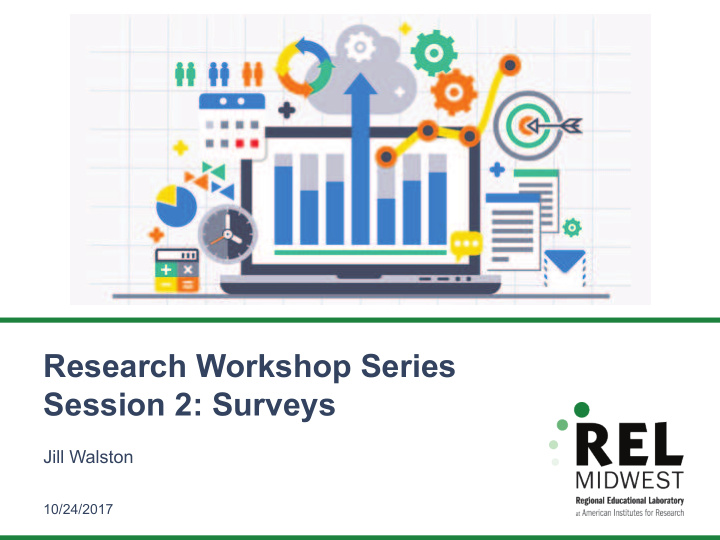



Research Workshop Series Session 2: Surveys Jill Walston 10/24/2017
Workshop Series 2017 September 28 Data, Research, and Evidence October 24 Survey Development and Administration November 15 Interviews and Focus Groups 2018 January 17 Observations and Rubric Development March 8 Data Analysis April 25 Communicating Research Findings
Today’s Goals 1. Discuss initial considerations for planning a survey project. 2. Learn how to write and test survey items. 3. Learn about techniques for maximizing response rates.
Planning for a survey
Gain consensus on the goals of the survey.
Create a timeline for survey development, administration, data analysis, and sharing results.
Define survey constructs. Family engagement Principal leadership Academic engagement School safety Discipline
Align and limit content to the goals.
Consider who will provide the most accurate data.
Define the target population.
Choose the most appropriate mode for administering the survey.
Activity: Handout 1 Work in your group to complete the survey planning form for your survey.
Developing survey content
Explore existing surveys.
NCES surveys
NCEE reports
Other resources: School climate
Guidelines for writing items
Be specific. Do you work full time? This is more specific. Currently, about how many total hours per week do you typically work for pay, counting all jobs?
Use clear directions where necessary— for example: • Select all that apply. • Select only one response. • Round to the nearest whole number. • Do not include long-term substitute teachers in your total count.
Avoid double-barreled items. Each item should represent a unidimensional concept.
Use appropriate reading level.
Typically, four to seven response categories are used for rating scales. My teacher grades fairly. Strongly disagree Disagree Agree Strongly agree
Using a neutral category
Types of rating scales • Agreement • Interest • Importance • Frequency • Degree or extent • Similarity ( like me to not like me )
For example:
Make responses mutually exclusive. What is wrong with this item? How many years have you been teaching? • 0–5 years • 5–10 years • 10+ years
Make responses collectively exhaustive. What is wrong with this item? How often do you assign homework? • Monthly • Weekly • Daily
Open-ended items
Methods to pretest survey items • Expert reviews • Cognitive interviews • Focus groups • Field testing
Cognitive interviews are a common pretesting strategy .
Concurrent “think-aloud”: Ask participants to verbalize what they are thinking.
Retrospective probing: Ask specific questions after responses. What does the How do you word participate remember. . .? here mean to you? In your own words, what is this question asking you to do? Was it easy or hard to answer this Can you tell me question? how sure you are that you. . .?
Cognitive interviews: Analysis Review notes and listen to audio recordings of interviews.
Activity: Handout 3 Work in your group to review survey items.
Survey administration considerations
Avoid convenience samples.
Start with a sampling frame.
It is not necessary to survey every member of the target population.
Large random samples are more representative than smaller random samples.
Consider subgroups of interest.
What is a response rate?
How do you maximize response rates?
Contact participants.
Online survey platforms at DPI • Qualtrics • Google Forms • Verint 4
Procedures for gaining consent
Final thoughts: Survey projects will need time for: • Planning • Survey content development • Survey administration • Data analysis • Sharing findings See Handout 4 for an example Gantt chart.
Jill Walston jwalston@air.org
Recommend
More recommend